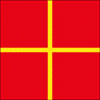|
Vincent Pica
Chief of Staff, First District, Southern Region (D1SR)
United States Coast Guard Auxiliary
|
“Sabby the Lingo?” Maritime Language – XX
As noted prior, each discipline has a language and that language conveys competency to the listener. This column is part of a series of maritime vocabulary words. So you can sound like the salty ol’ mariner you are… We’ll run enough of these to get the major concepts and phraseology from Alpha to Zulu in front of you!
|
 |
| International Meaning: No meaning. Navy Meaning: Preparing to replenish (At sea). Ready duty ship (In port). |
|
|
- Reef Knot - [image] - Also known as the square knot, it is formed by two half hitches in which the ends always fall in line with the outer parts. This knot is used to loosely tie lines around the bundles of sail that are not in use after reefing.
- Reefing - The operation of reducing a sail by taking in one or more of the reefs.
- Reeve - To pass or lead a line through a block or other object. When the end of a line is passed through anything, it is said to be "rove" through it.
|
- Relative Bearing - Direction or bearing of an object relative to a boat's heading.
- Repel Boarders - An order announced for the ship's company to arm themselves to prevent boarding of their ship.
- Reserve Buoyancy - The lifting power. It may be measured by the volume of a watertight hull above the load water line.
- Rhumb Line - A straight line compass course between two points. A line on the earth's surface which intersects all meridians at the same angle.
- Ride To - Lie at anchor
- Riding Light - An all around white light displayed at night by a ship when she is anchored.
- Right of Way - The right to maintain a course according to the Rules of Navigation. When two boats are on intersecting courses, one is the "stand-on" vessel (has "right of way" and must hold its course steady) so the other "give-way" vessel may steer clear.
- Rip Tide - The rip tide is not a tide, it is a current. When waves hit the beach they hit at an angle and push water ahead of them. This water forms a current that flows parallel to the shore, called the longshore current. When the shape of the beach changes, or its direction (as in from North-South to Northeast-Southwest) the speed of the current changes. Locally this can cause more water to flow into an area than can flow out, and water will pile up. This is much like a traffic jam for the currents. However, the water, which is trapped next to the shore, cannot get out because of the longshore current. Eventually, so much water will pile up that it can break through the longshore current in a small area. The large amount of water rushing through a small break causes a strong current in a small area that flows perpendicular (away) from the shore. This is the rip tide.
- Rips - Short, steep waves caused by the meeting of currents.
- Rode - The anchor line, cable or chain that connect the anchor to the boat.
- Rogue Knot - Seaman's name for a reef knot tied upside down. also called a "granny" knot.
- Rooming - The navigable water to leeward of a vessel.
- Rope - When rope comes aboard a vessel and is put to use, it is called line, although some still call it rope if it is over one inch in diameter. A coil of rope that is not designated for any particular use.
- Rose Box - The strainer at the end of the suction pipe of a bilge pump which prevents solid material in the bilges from being sucked into the pump and choking it. Also known as a strum box.
- Rules of the Road - The rules concerning which vessel has the right of way if there is a possibility of collision between two or more boats; written to prevent accidents and collisions; includes right of way, lights, pennants, and whistle signals
- Run Aground - To take a boat into water that is too shallow for it to float in, i.e: the bottom of the boat is resting on the ground.
- Run Out - To put out a mooring, hawser or line from a ship to a point of attachment outside her.
- Running - Sailing in the same direction as the wind with the wind coming from the stern.
- Running Backstay, Runners - Adjustable stays used to support and control tension on the mast when the wind is from abaft the beam; temporary backstays used to stabilize the mast and prevent undue flexing due to the pumping action of the sea.
- Running Bowline - [image ] - A type of knot that tightens under load. It is formed by running the standing line through the loop formed in a regular bowline, or by tying around a bight in the line.
- Running Fix - A fix taken by taking bearings of a single object over a period of time. By using the vessel's known course and speed, the location of the vessel can be found.
- Running Lights - Lights required to be shown on boats underway between sunset and sunrise; they tell other vessels not only where you are, but what you are doing.
More in the weeks ahead…!
|
BTW, if you are interested in being part of USCG Forces, email me at JoinUSCGAux@aol.com or go direct to the D1SR Human Resources department, who are in charge of new members matters, at DSO-HR and we will help you “get in this thing…”
|
| <-- click there to tweet, post or otherwise distribute to the 'net
|
|